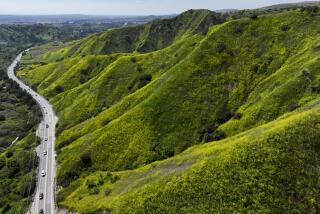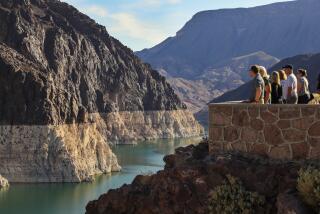Relentless drought is turning California into Nevada
- Share via
A couple of weeks ago, I was flying to a conference in Sun Valley. The passenger next to me was looking out the window, down at the dry, barren landscape below. He asked me if I knew where we were and I said, “I think it’s Nevada, but it could be the moon.”
Nevada is a perfectly fine state, but it is largely arid and empty. From a few thousand feet in the air, it bears no resemblance to the parts of the planet that are wet and green and verdant. With Gov. Jerry Brown’s implementation of unprecedented water-use restrictions in response to California’s fourth year of severe drought, it’s not unreasonable to wonder if the Golden State is becoming Nevada.
Brown made his announcement that all jurisdictions in the state must cut water consumption by 25% while he stood on dry ground in the Sierra that he said normally would be covered by five feet of snow. The mountain snowpack is just 12% of average, which means dramatically diminished runoff going into reservoirs that currently have about a year’s supply left. That does not mean there will be no water for Californians. The reservoirs will get a small boost from whatever rains do come. There are also vast, ancient aquifers with reserves of water that could last a decade. But, unlike the reservoirs, the aquifers filled up in millenniums long past and would take a century or more to restore.
California’s Central Valley, one of the most productive agricultural regions the world has ever seen, sits on top of those aquifers. The people who grow the strawberries, pistachios, almonds and other crops that feed America have been forced to pump more and more water from the aquifers in order to stay in business. Now, the land is sinking as the space underground is emptied. Geologists and hydrologists warn that overpumping is bringing farmers closer to a day when the only water left in the ground will be too deep, too poor in quality and too costly to bring to the surface.
Agricultural interests, though, have successfully lobbied against state regulations that would restrict groundwater use. For now, growers can drill a well wherever they want and keep sucking up water from the aquifers. It’s not hard to understand what the growers are thinking. They just want to hang on long enough to see the drought end and water for irrigation spilling down from the mountains once again.
Wetter days will return to California, but it could be temporary. Scientific projections about climate change strongly suggest that the new normal will be far drier than in the past century, when the state’s agriculture industry was built on irrigation of otherwise unproductive land. If drought, occasionally interrupted by a diminished dose of rain and snow, is the new normal, then farmers will be hard pressed to survive. And that would be not just a tragedy for them or a disaster for California’s economy, it would be a huge problem for the country.
According to the Western Farm Press, California “produces a sizable majority of American fruits, vegetables and nuts; 99 percent of walnuts, 97 percent of kiwis, 97 percent of plums, 95 percent of celery, 95 percent of garlic, 89 percent of cauliflower, 71 percent of spinach, and 69 percent of carrots and the list goes on and on. ... No other state, or even a combination of states, can match California’s output per acre.”
If that productivity goes away -- along with a significant share of the state’s huge livestock industry -- consumer prices throughout the United States will shoot up and people’s food choices will be severely pinched. What is truly scary is that, if the science is right, it is difficult to imagine how such a dried-up future can be avoided.
If California’s agricultural heartland becomes as much a desert as Nevada, even reviving empty farming towns with a string of Reno-style casinos would not come close to replacing the bonanza that water once created.
More to Read
A cure for the common opinion
Get thought-provoking perspectives with our weekly newsletter.
You may occasionally receive promotional content from the Los Angeles Times.







